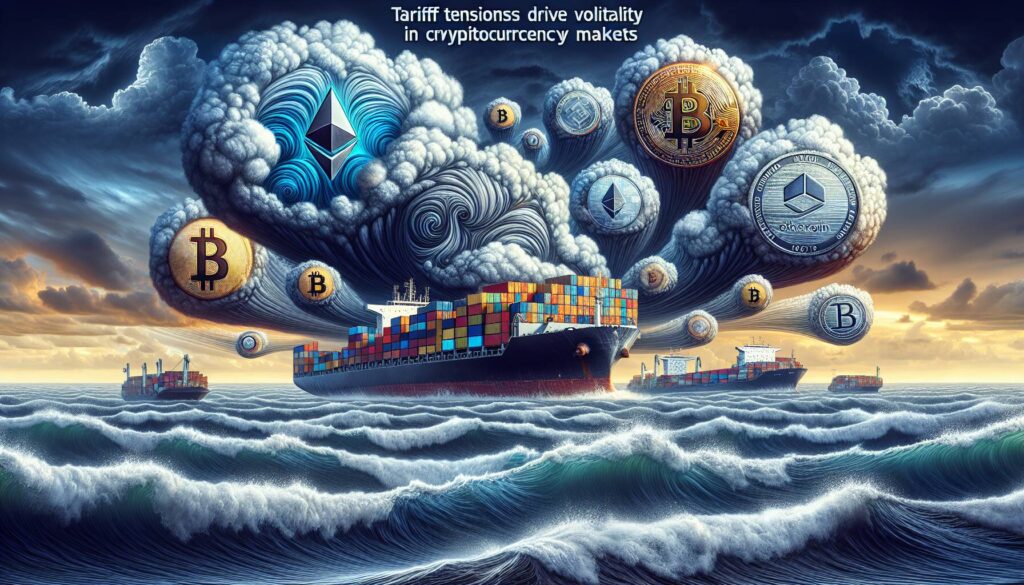The cryptocurrency landscape is witnessing a fascinating shift, as the market reacts to external economic influences, particularly U.S. tariffs. As outlined by Omkar Godbole, this week’s events have been marked by sharp fluctuations in Bitcoin’s price, driven primarily by President Trump’s unexpected tariff announcements. The concepts of “risk-on” and “risk-off” have often dictated market sentiments, but we now seem to be entering a new phase defined by “tariffs on” and “tariffs off.”
On Monday, Bitcoin’s value dropped to nearly ,000 following retaliatory measures from Canada and Mexico against U.S. tariffs, leading investors to adopt a more cautious stance. However, a brief reprieve was felt when Trump paused tariffs on Mexico for 30 days, causing Bitcoin to rebound above 0,000 as hopes of renewed investments in digital currencies emerged. This rollercoaster of emotions illustrates just how interconnected cryptocurrency markets are with broader economic policies.
As global tensions escalated with China’s retaliatory tariffs, Bitcoin again saw a downward trend, prompting concerns of heightened volatility. Notably, foreign-exchange indicators are showing signs that traders expect a potential resolution to the trade spat, as evidenced by the relatively muted performance of the Australian dollar against the Canadian dollar.
“Expect heightened volatility and stay alert!”
This swirling landscape of tariffs and trade has precipitated not only wild price swings in Bitcoin but also a ripple effect across altcoins and stocks. With upcoming macroeconomic indicators and network upgrades in the crypto sphere, all eyes are on how these developments will unfold amidst the backdrop of trade negotiations. As we navigate this tumultuous period, the cryptocurrency market is bound to react dynamically, reflecting the intricate interplay between economic policy and digital assets.

Understanding the Impact of Tariff Policies on Financial Markets
As financial markets react to the evolving landscape of tariff announcements, here are some key points to consider:
- Risk-On vs Risk-Off Markets:
- In a risk-on environment, assets like stocks and cryptocurrencies typically see price increases due to positive economic forecasts.
- In contrast, a risk-off environment prompts investors to seek safer assets, resulting in market sell-offs.
- Recent Market Volatility:
- President Trump’s tariffs led to significant fluctuations in the price of Bitcoin (BTC), showcasing how sensitive markets are to political decisions.
- Tariff announcements can trigger sharp movements in cryptocurrency and equity markets, affecting investment strategies for individual investors.
- International Trade Relations:
- Retaliation by other countries, such as Canada and Mexico, can impact U.S. markets and investor confidence.
- Potential trade deals may stabilize markets if announced timely; optimism surrounding such developments can lead to price rebounds in risk-sensitive assets.
- Macro Economic Indicators:
- Key economic reports, like the Job Openings and Labor Turnover Survey (JOLTS), provide insights into labor market health and economic growth prospects, impacting investor sentiment.
- Upcoming speeches and reports from Federal Reserve officials and economic authorities can further influence market expectations.
- Preparedness for Volatility:
- Investors are advised to stay alert and prepared for market volatility due to changing political and economic landscapes.
- Monitoring derivative positions and sentiment can help investors align their strategies with current market dynamics.
The relationship between tariff policies, market reactions, and economic indicators is crucial for retail investors. Understanding these factors can aid in making informed decisions and managing risk in volatile environments.
Market Volatility: The Tariffs Showdown and Its Ripple Effects on Cryptos
The current market landscape is increasingly defined by a new duality of “tariffs on/tariffs off,” fundamentally altering the investment strategies and sentiment among traders and investors alike. This dynamic has been acutely highlighted by President Trump’s recent tariff announcements, which send financial markets into a state of flux. In this evolving narrative, bitcoin and other cryptocurrencies are becoming prominent bellwethers for broader market movements, akin to how traditional equities respond to economic policy changes.
Competitive Advantages: One of the primary advantages in this market scenario is the heightened volatility that provides traders with substantial opportunities for profit through swift trades. In particular, assets like bitcoin have demonstrated a robust capacity for quick recoveries. The ability for traders to pivot quickly, especially in the crypto space where trades can be executed 24/7, signifies an agility that old-world financial markets often lack. Additionally, the growing optimism surrounding potential negotiations between the U.S. and China adds a speculative edge to trades, particularly for risk-on assets.
Disadvantages: However, this boom is not without its pitfalls. The fear of unexpected changes can lead to significant losses, as trading environments shift rapidly between risk-on and risk-off scenarios. This unpredictability can discourage cautious investors, leading them to shy away from the market or limit their exposure to riskier assets. The stark price swings noted this past week, where bitcoin oscillated drastically due to tariff announcements, epitomize the inherent risks in such a volatile landscape. Additionally, any extended tariff war or trade destruction could culminate in an overall downturn in investor confidence, further compounding the market’s instability.
The current environment is poised to benefit aggressive traders who thrive on volatility. They can capitalize on swift market changes and leverage technical analysis to make rapid decisions. Conversely, those with a more risk-averse portfolio strategy may find themselves in murky waters, grappling with the uncertainty and potential catastrophic loss. The implications extend beyond individual traders, impacting institutional investors who need to navigate complex geopolitical landscapes while maintaining market integrity.
This evolving situation illuminates just how fragile the connection between asset classes and geopolitical factors can be. As investors remain alert to any developments in trade negotiations, the ability to adapt will be crucial. The challenge lies in striking a balance between seizing opportunities and managing risks inherent in a market susceptible to rapid shifts driven by political decision-making.
















